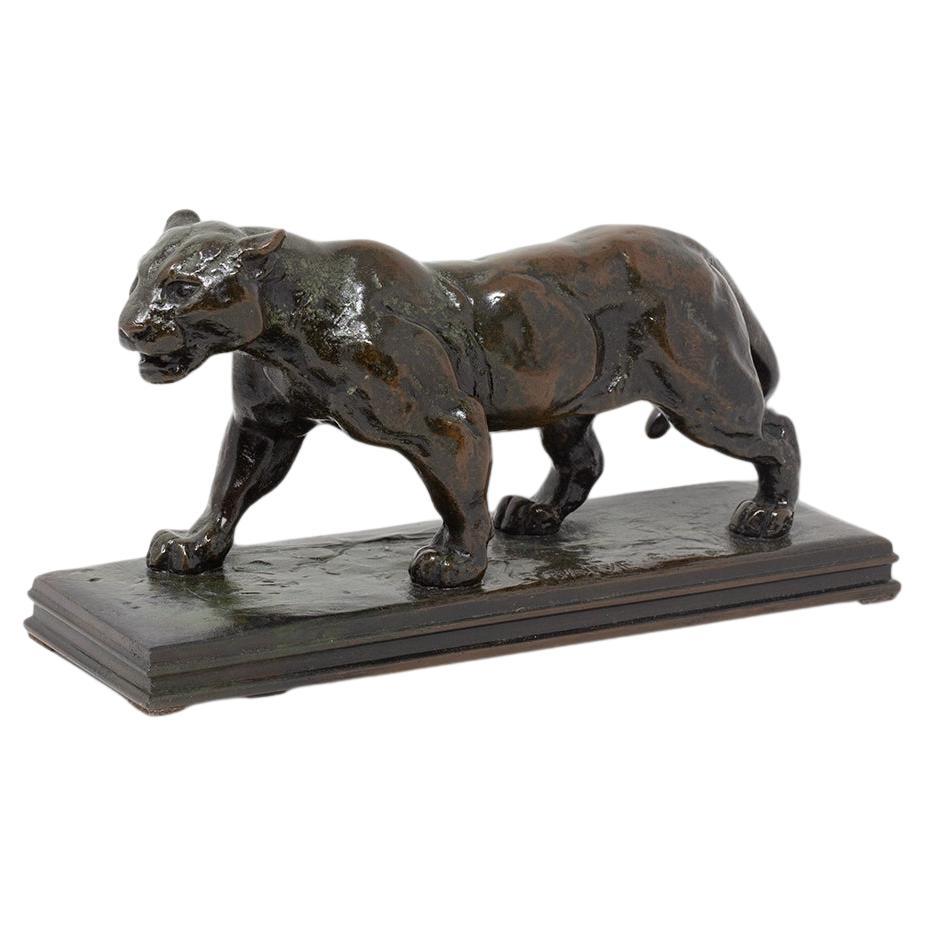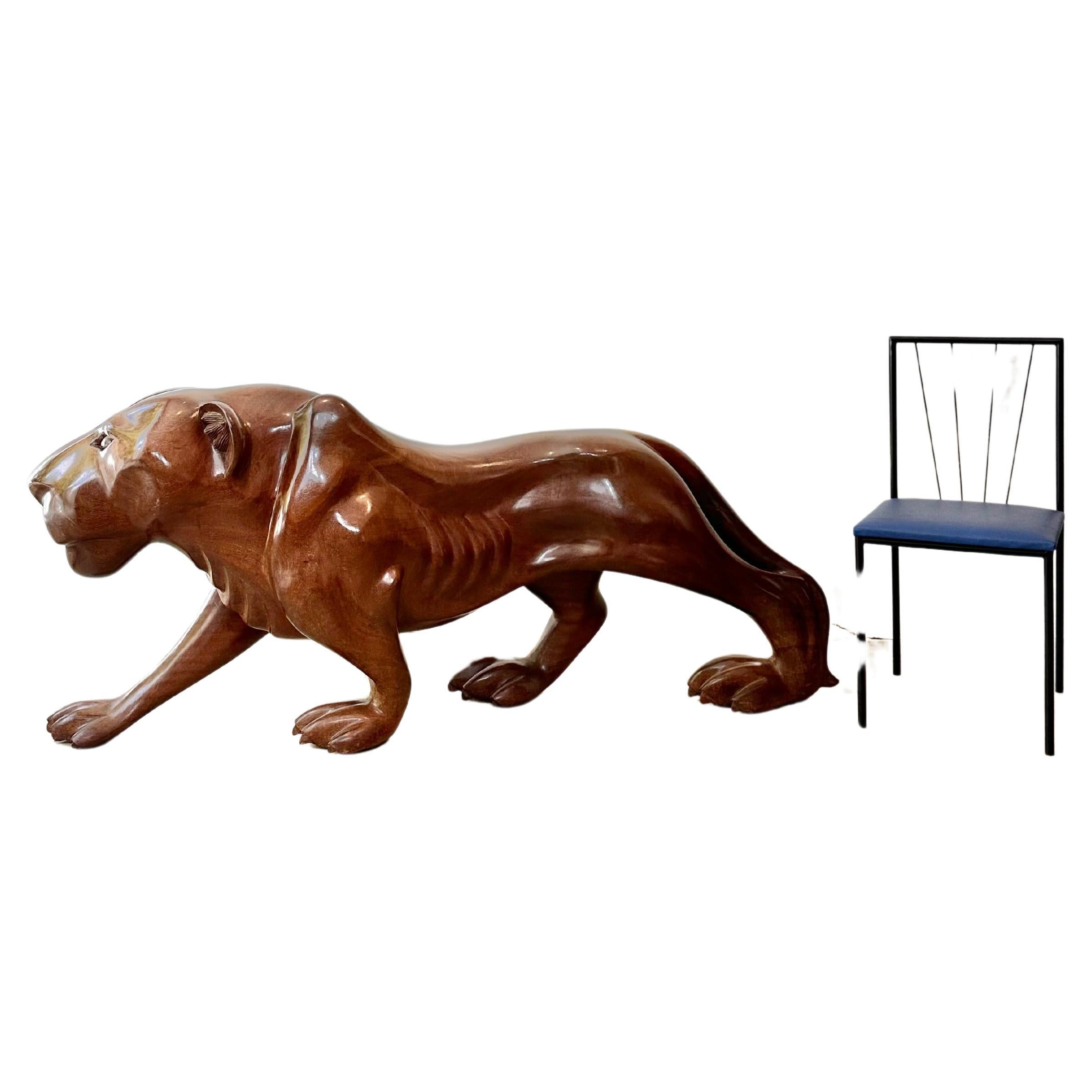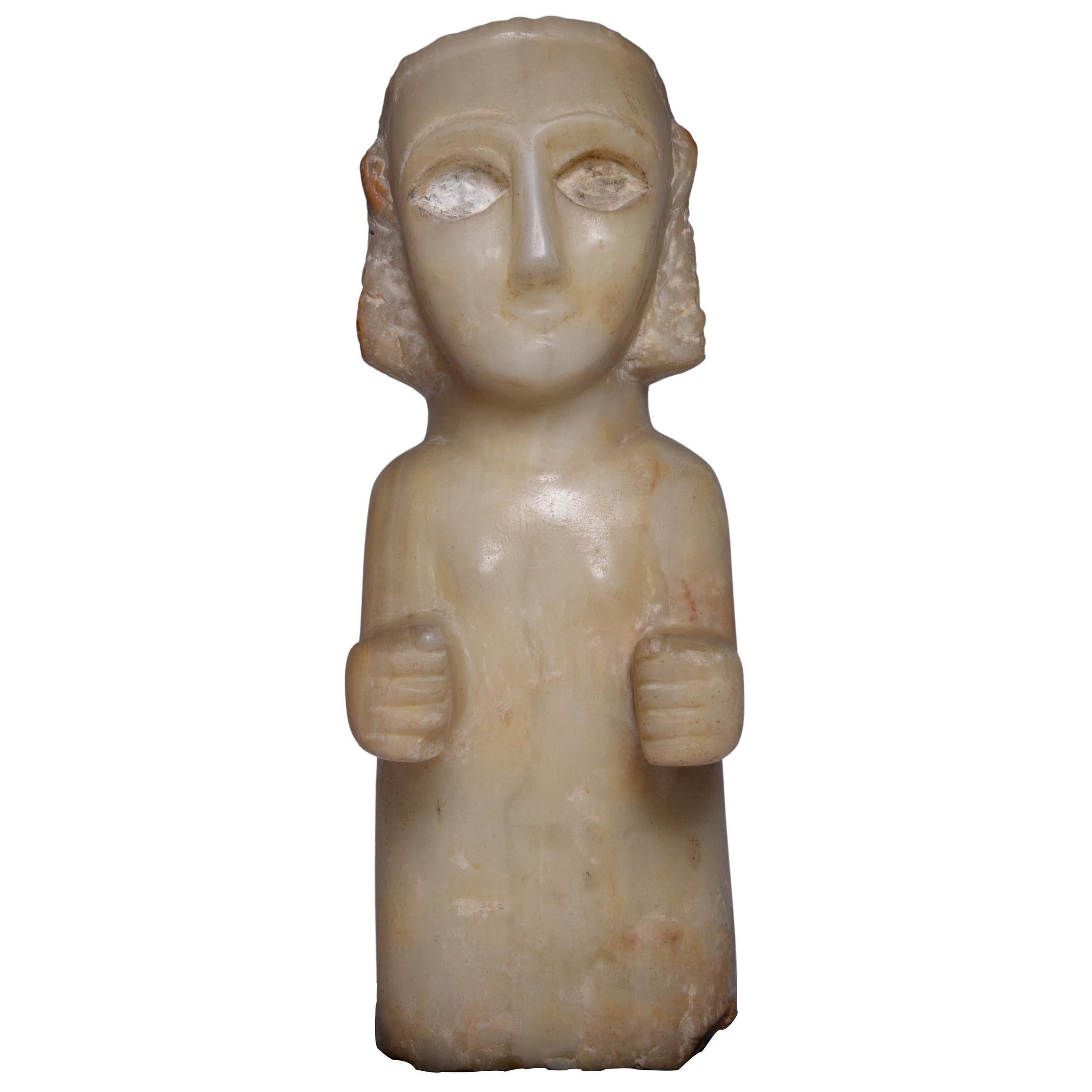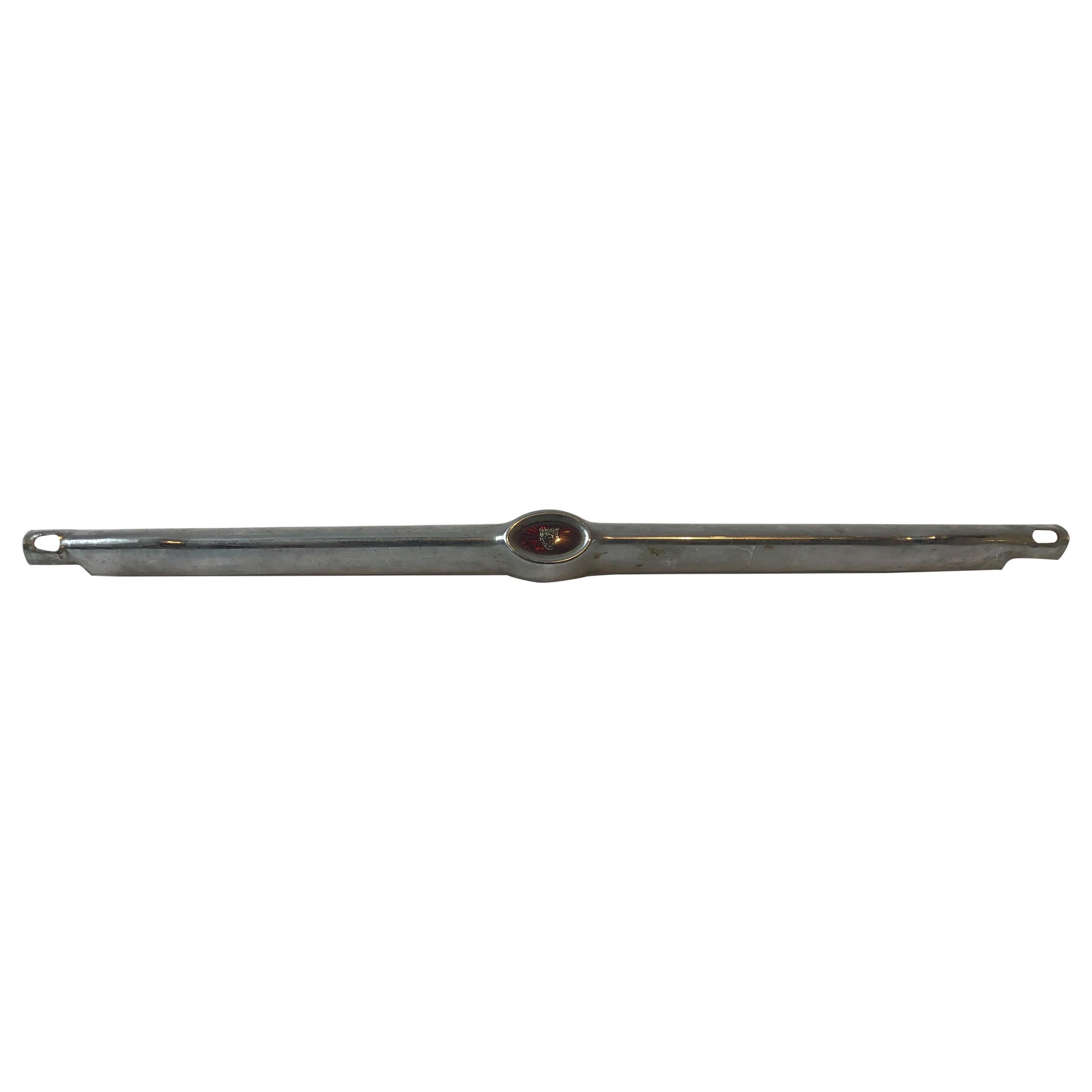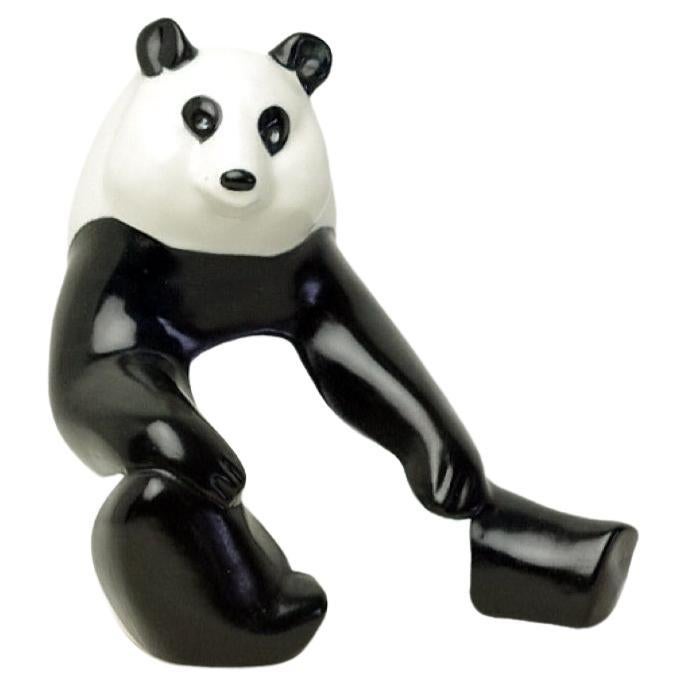Video Loading
Want more images or videos?
Request additional images or videos from the seller
1 of 8
Arabian Nights Jaguar
About the Item
The Arabian Nights Jaguar by Hechizoo, a black cast bronze sculpture that captures the essence of power, grace, and mystique embodied by the enigmatic jaguar. This remarkable piece, cast in bronze with meticulous craftsmanship, stands as a testament to Hechizoo's ability to blend traditional forms with contemporary design. The juxtaposition of the jaguar's primal presence with the geometric precision of the diamond pattern creates a visual dialogue that resonates with both contemporary aesthetics and timeless natural beauty
As a symbol of strength and resilience, the jaguar becomes more than just a sculpture—it is an embodiment of Hechizoo's dedication to creating transformative pieces. The play of light on the cast bronze surface adds depth and dimension to the intricate diamond pattern, making the Arabian Nights Jaguar a captivating exploration of form and texture.
- Creator:Hechizoo (Artist)
- Dimensions:Height: 52 in (132.08 cm)Width: 20 in (50.8 cm)Depth: 25 in (63.5 cm)
- Materials and Techniques:Bronze,Cast
- Place of Origin:
- Period:
- Date of Manufacture:2023
- Production Type:New & Custom(One of a Kind)
- Estimated Production Time:Available Now
- Condition:
- Seller Location:New York, NY
- Reference Number:1stDibs: LU1834337536662
About the Seller
No Reviews Yet
Recognized Seller
These prestigious sellers are industry leaders and represent the highest echelon for item quality and design.
Established in 2001
1stDibs seller since 2016
12 sales on 1stDibs
- ShippingRetrieving quote...Ships From: New York, NY
- Return PolicyThis item cannot be returned.
More From This SellerView All
- Inga IguanaBy HechizooLocated in New York, NYThe "Inga Iguana," a remarkable creation by Hechizoo that transcends traditional artistic boundaries. This black cast bronze iguana is a fusion of meticulous craftsmanship and imagin...Category
2010s Colombian Animal Sculptures
MaterialsBronze
- AnteaterBy HechizooLocated in New York, NY"Anteater," is a magnificent sculpture by Hechizoo that embodies the intersection of artistic mastery and cultural innovation. Rooted in the recent exhibition "Original Sin" and guid...Category
2010s Colombian Animal Sculptures
MaterialsMetal, Bronze, Copper
- Salento ArmadilloBy HechizooLocated in New York, NY"Salento Armadillo" by Hechizoo, is a captivating cast bronze sculpture that seamlessly blends the organic form of an armadillo with one of the studio's signature rug pattern innovat...Category
2010s Colombian Animal Sculptures
MaterialsBronze
- Original Sin RunnerBy HechizooLocated in New York, NYThe "Original Sin Runner," a mesmerizing work of art crafted in 2023 by the skilled hands of Jorge Lizarazo, the visionary behind Hechizoo, unveils a rich tapestry of nature and intr...Category
2010s Colombian North and South American Rugs
MaterialsBronze, Tin, Copper
- Werregue TableBy HechizooLocated in New York, NYWerregues Tables are a coiled trio of exquisite creations by Hechizoo that exemplify the studio's dedication to innovation and craftsmanship. Crafted from a harmonious blend of vinyl...Category
Early 2000s Colombian Side Tables
MaterialsNatural Fiber
- Alpaca ChairBy HechizooLocated in New York, NYThis rounded chair by visionary artist Jorge Lizarazo exemplifies the studio's commitment to transcending design boundaries with Colombian flair. Drawing inspiration from the iconic ...Category
2010s South American Chairs
MaterialsMetal, Copper
You May Also Like
- Jaguar Qui Marche No. 2 (Walking Jaguar) Antoine L BaryeBy Antoine-Louis BaryeLocated in Newark, EnglandFrom our Sculpture collection, we are delighted to offer this Jaguar Qui Marche No. 2 (Walking Jaguar) Bronze by Antoine-Louis Barye. The Jaguar Qui Marche translates directly to Jag...Category
Antique Mid-19th Century French Louis Philippe Animal Sculptures
MaterialsBronze
- Jaguar Sculpture in WoodLocated in Sao Paulo, SPImpressive sculpture of a female Brazilian jaguar made in a huge single wood block. This piece was exceptionally well-executed, made in the 1930/1940'...Category
Vintage 1930s Brazilian Modern Animal Sculptures
MaterialsWood
- Ancient South Arabian Alabaster StatueLocated in London, GBSouth Arabian Calcite female figure 3rd Century BC to 1st century A.D. Calcite Alabaster height: 30.5 cm A magnificent alabaster female figure, a f...Category
Antique 15th Century and Earlier Yemeni Figurative Sculptures
MaterialsAlabaster
- Ancient South Arabian Alabaster InscriptionLocated in London, GBSouth Arabian Alabaster Inscription Calcite Alabaster circa 1st century A.D. ‘’Consequently, neither white marble of Paros nor any other stone which men admire can be compared with the precious stones of Arabia, since their whiteness is most brilliant, their weight the heaviest, and their smoothness leaves no room for other stones to surpass them.’’ - Diodorus Siculus, Library of History, Book II, 52.9 This inscription, finely worked on an alabaster tablet, is a remarkably well preserved example of Ancient South Arabian script, with its distinct bold, angular forms, written in the Qatabanic dialect - that is, the dialect spoken by the people of the kingdom of Qataban, which ruled much of modern day Yemen from the 7th Century B.C. to the 2nd Century A.D. The text, which reads: ‘[... ...]sa?d and Ma?add?i- / (of the lineage) of Hawfa- / She entrusted Anb- / against any malfeasance (which would remove it) from its place’ - indicates that it likely served to commemorate a temple offering. The quality of the script, incised so neatly into the surface of the alabaster, tells us that this piece was commissioned by somebody of considerable wealth and prestige, employing a scribe of equally considerable expertise. South Arabia was known throughout the ancient world for its incredible wealth - so much so that the Romans termed the region ‘Arabia Felix’ - literally, ‘Happy, or Fortunate, Arabia.’ That wealth was built largely on the trade of spices and incense, in which the Kingdom of Qataban played a major part. According to Pliny the Elder, this was the sole country through which frankincense could be exported, first being collected in the city of Shabwa, on the South Arabian coast, and from there travelling by camel up to Gaza, to be shipped all across the Mediterranean - not only that, but all growers of myrrh across Arabia were required to give a quarter of their yield to the king of the Qatabanians. As such, the kingdom became exceedingly rich and powerful, and Pliny goes on to tell us that ‘The nations of the Larendani and the Catabani, and the Gebanitæ [...] occupy a great number of towns, the largest of which are Nagia, and Thomna (the capital of Qataban) with sixty-five temples, a number which fully bespeaks its size.’ Because of the nature of its exports, frankincense in particular - the ‘sweat of of the gods’ according to the Egyptian Book of the Dead, and perhaps most famous as one of the three gifts brought to the newborn Christ - being closely associated with the divine, South Arabia’s reputation in antiquity was as a mysterious, almost sacred, and - crucially - extraordinarily wealthy region, at the very edge of the known world; in the words of Herodotus: ‘’Enough of marvels, and yet the land of Arabia gives off a scent as sweet as if divine.’’ This inscription invokes the protection of god Anbay, the judge-oracle of the chief god ‘Amm, who he served as an attendant. Much of what we know of the religious life of the ancient South Arabians comes to us from early Islamic texts, describing what is known in Islamic scholarship as ‘Jahiliyyah’ - the age before the advent of Islam in Arabia. What comes across in much of these texts is that these religious practices placed a great deal of emphasis on sacred stones, perhaps linked to the brilliance of the alabaster which is local to the region, and which a great many of the cult-objects produced in this time are made from. Hisham ibn-Al-Kalbi’s Book of Idols records: ‘’The Arabs were passionately fond of worshipping idols [...] Whenever a traveller stopped at a place or station in order to rest or spend the night, he would select for himself four stones, pick out the finest among them and adopt it as his god, and use the remaining three as supports for his cooking-pot.’’ This inscription was once in the collection of the intrepid British-Australian travel...Category
Antique 15th Century and Earlier Yemeni Abstract Sculptures
MaterialsAlabaster
- 1960s E Type Jaguar Front FenderLocated in Tarrytown, NY1960s E Type Jaguar front fender.Category
Vintage 1960s Figurative Sculptures
MaterialsSteel
- Lillemor Mannerheim Klingspor, Panda WWF, ArabiaBy Lillemor Mannerheim, ArabiaLocated in MAASTRICHT, LIProduct Description: This panda designed by Lillemor Mannerheim was made for WWF and part of the sales of the items was donated to this organisation. Mannerheim, being a member of ...Category
Vintage 1980s Finnish Animal Sculptures
MaterialsFaience
Recently Viewed
View AllMore Ways To Browse
19th Bronze French Racehorse
Vintage Staffordshire Spaniels
Lion Figurine Italy
Rabbit Figurine Crystal
Mexican Metal Furniture
Eduard Frere
Mid Century Brass Deer
Fish Sticker
Small Antique Dog Statues
The Pharaohs Horses
Life Size Dog Sculpture
Lion Life Size Sculpture
Carved Wooden Horse Head
Millefiori Fish
Dog Leg Study
White Italian Ceramic Rooster
Green Incense Burner Parrots
Hubley Scottie
